Employee Motivations: Research Analysis and Summary Report
VerifiedAdded on 2022/11/23
|12
|3361
|293
Report
AI Summary
This report analyzes employee motivation, focusing on research comparing public and private sectors. The analysis examines three key articles, exploring methodologies used, including surveys and experimental methods, to assess factors influencing employee motivation. The studies by Cowley et al. (2013), Bullock et al. (2015), and Belle (2015) are evaluated for their validity, reliability, and credibility, highlighting the strengths and limitations of each approach. The report delves into how different motivational factors, such as performance-related pay, communication, training, and job security, impact employee engagement and organizational outcomes. It also discusses key findings from various researchers on the importance of remuneration, commitment, and workplace culture in fostering a motivated workforce. The report concludes by identifying critical areas of concern for organizations seeking to retain a motivated workforce and the factors that influence employee motivation in both sectors.
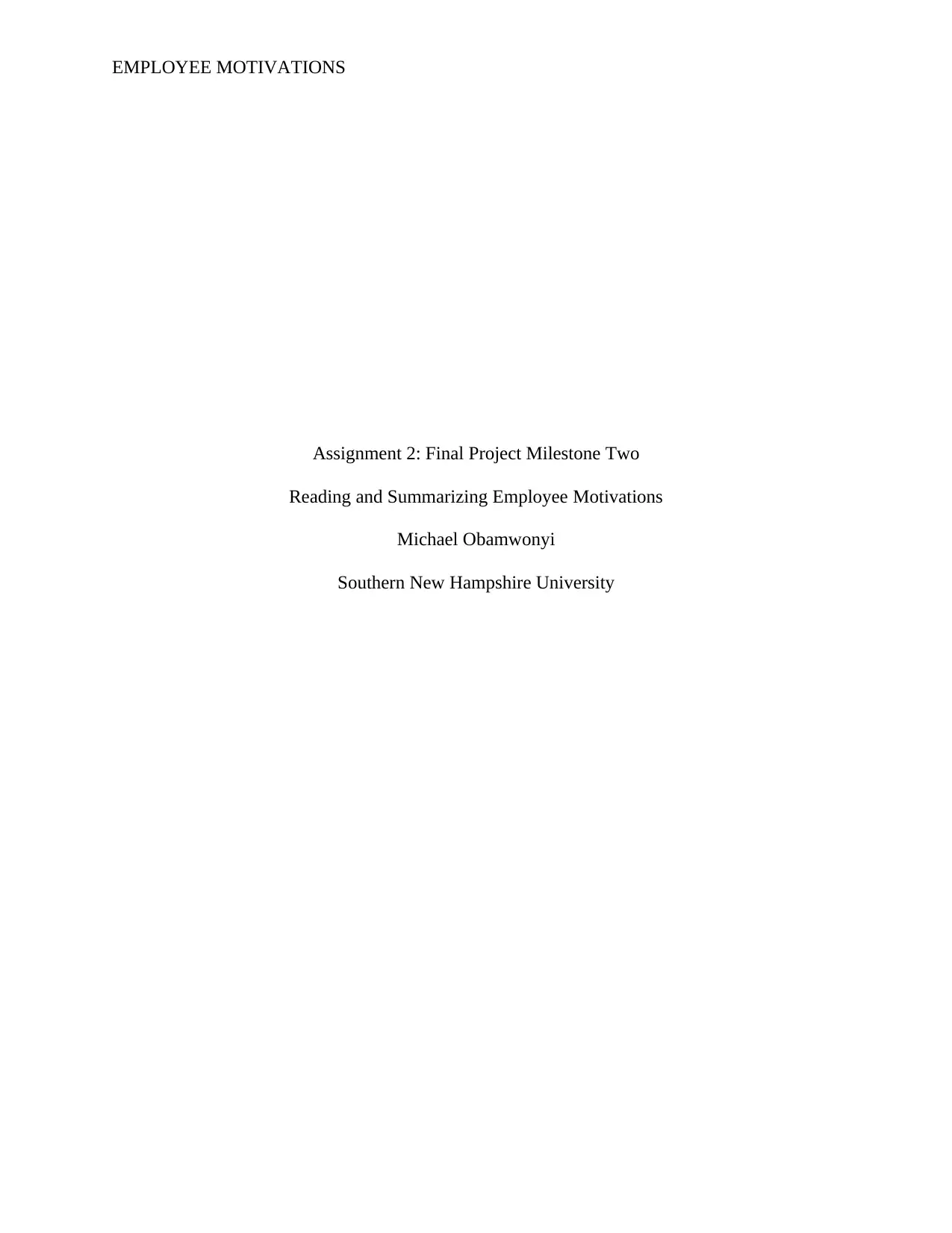
EMPLOYEE MOTIVATIONS
Assignment 2: Final Project Milestone Two
Reading and Summarizing Employee Motivations
Michael Obamwonyi
Southern New Hampshire University
Assignment 2: Final Project Milestone Two
Reading and Summarizing Employee Motivations
Michael Obamwonyi
Southern New Hampshire University
Paraphrase This Document
Need a fresh take? Get an instant paraphrase of this document with our AI Paraphraser
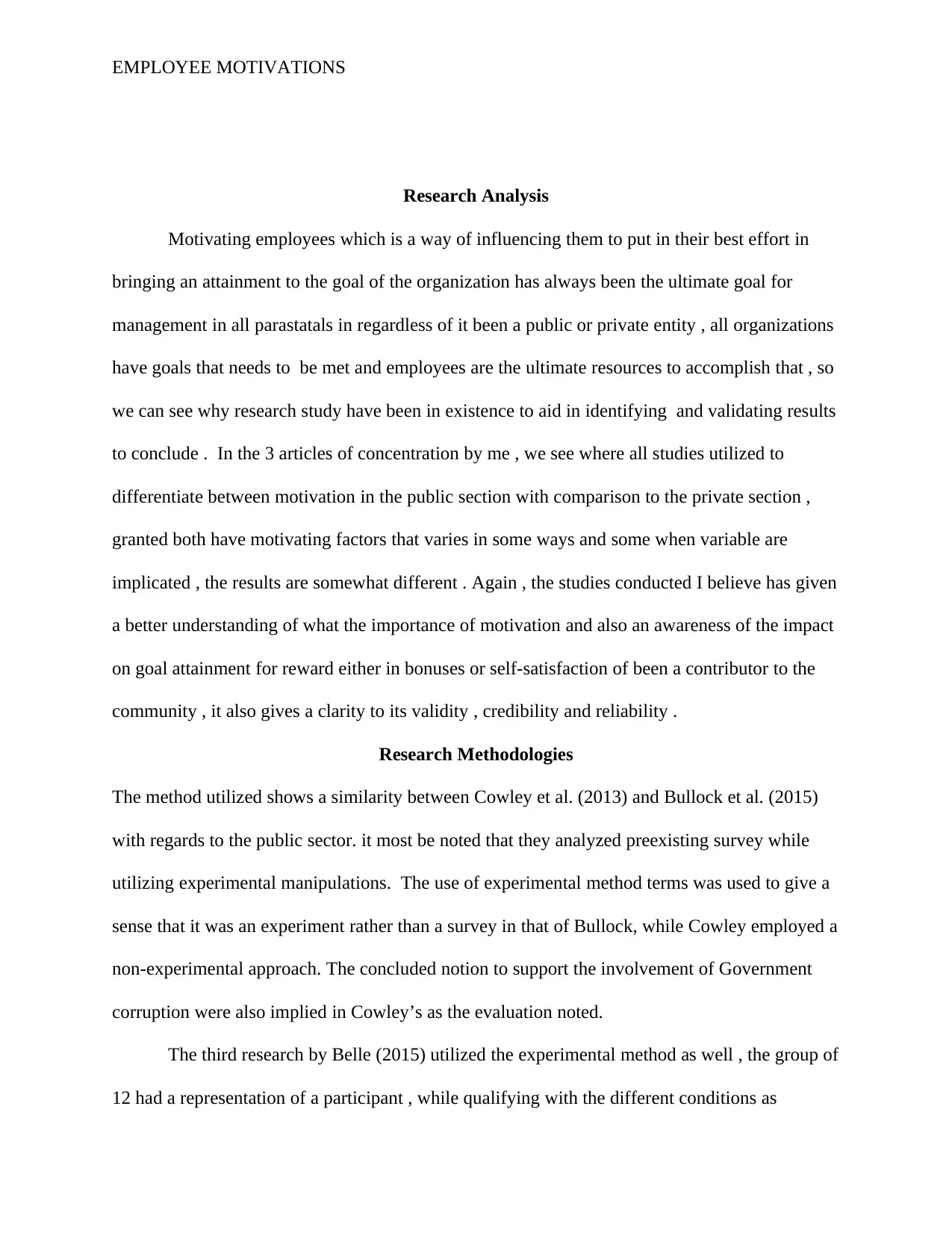
EMPLOYEE MOTIVATIONS
Research Analysis
Motivating employees which is a way of influencing them to put in their best effort in
bringing an attainment to the goal of the organization has always been the ultimate goal for
management in all parastatals in regardless of it been a public or private entity , all organizations
have goals that needs to be met and employees are the ultimate resources to accomplish that , so
we can see why research study have been in existence to aid in identifying and validating results
to conclude . In the 3 articles of concentration by me , we see where all studies utilized to
differentiate between motivation in the public section with comparison to the private section ,
granted both have motivating factors that varies in some ways and some when variable are
implicated , the results are somewhat different . Again , the studies conducted I believe has given
a better understanding of what the importance of motivation and also an awareness of the impact
on goal attainment for reward either in bonuses or self-satisfaction of been a contributor to the
community , it also gives a clarity to its validity , credibility and reliability .
Research Methodologies
The method utilized shows a similarity between Cowley et al. (2013) and Bullock et al. (2015)
with regards to the public sector. it most be noted that they analyzed preexisting survey while
utilizing experimental manipulations. The use of experimental method terms was used to give a
sense that it was an experiment rather than a survey in that of Bullock, while Cowley employed a
non-experimental approach. The concluded notion to support the involvement of Government
corruption were also implied in Cowley’s as the evaluation noted.
The third research by Belle (2015) utilized the experimental method as well , the group of
12 had a representation of a participant , while qualifying with the different conditions as
Research Analysis
Motivating employees which is a way of influencing them to put in their best effort in
bringing an attainment to the goal of the organization has always been the ultimate goal for
management in all parastatals in regardless of it been a public or private entity , all organizations
have goals that needs to be met and employees are the ultimate resources to accomplish that , so
we can see why research study have been in existence to aid in identifying and validating results
to conclude . In the 3 articles of concentration by me , we see where all studies utilized to
differentiate between motivation in the public section with comparison to the private section ,
granted both have motivating factors that varies in some ways and some when variable are
implicated , the results are somewhat different . Again , the studies conducted I believe has given
a better understanding of what the importance of motivation and also an awareness of the impact
on goal attainment for reward either in bonuses or self-satisfaction of been a contributor to the
community , it also gives a clarity to its validity , credibility and reliability .
Research Methodologies
The method utilized shows a similarity between Cowley et al. (2013) and Bullock et al. (2015)
with regards to the public sector. it most be noted that they analyzed preexisting survey while
utilizing experimental manipulations. The use of experimental method terms was used to give a
sense that it was an experiment rather than a survey in that of Bullock, while Cowley employed a
non-experimental approach. The concluded notion to support the involvement of Government
corruption were also implied in Cowley’s as the evaluation noted.
The third research by Belle (2015) utilized the experimental method as well , the group of
12 had a representation of a participant , while qualifying with the different conditions as
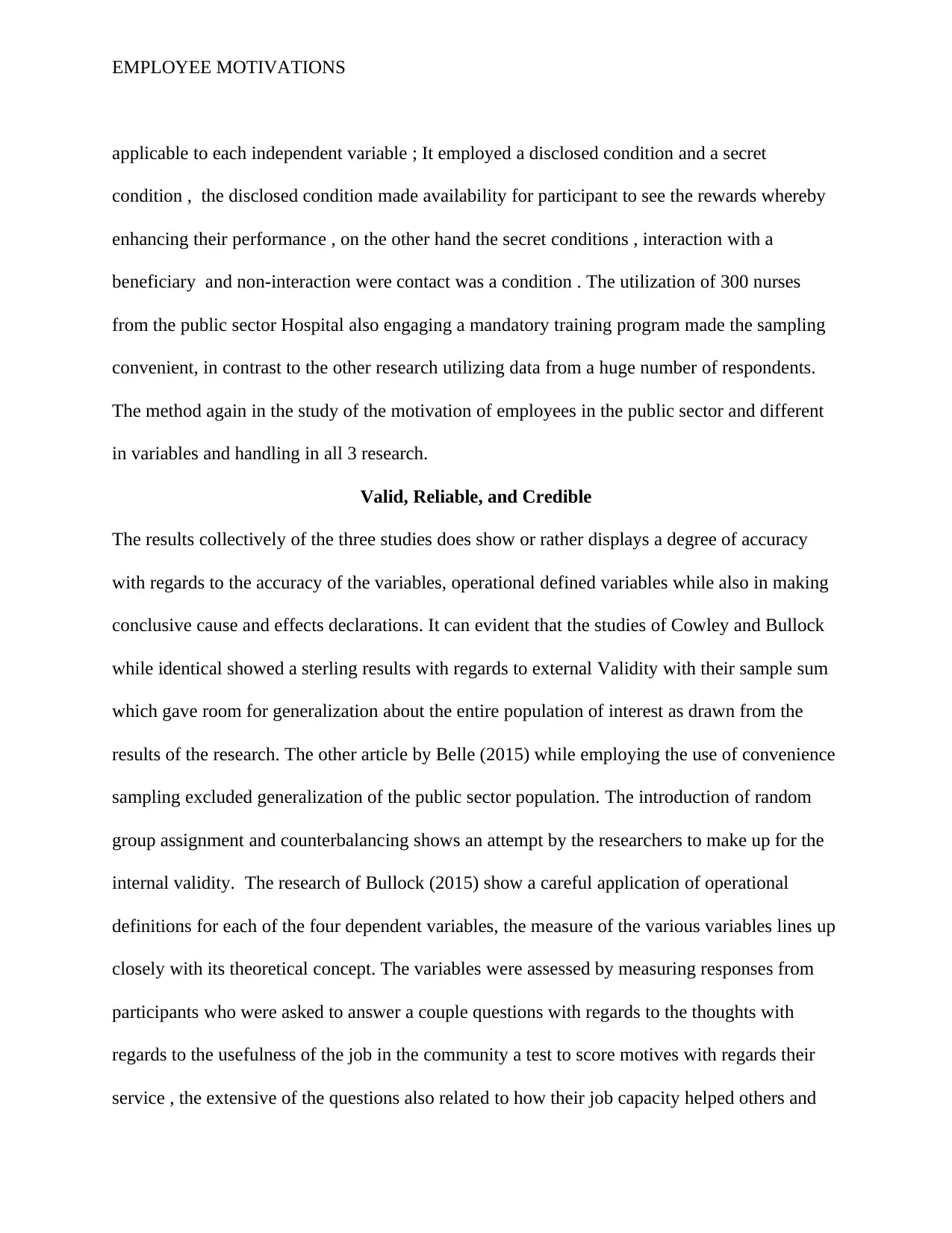
EMPLOYEE MOTIVATIONS
applicable to each independent variable ; It employed a disclosed condition and a secret
condition , the disclosed condition made availability for participant to see the rewards whereby
enhancing their performance , on the other hand the secret conditions , interaction with a
beneficiary and non-interaction were contact was a condition . The utilization of 300 nurses
from the public sector Hospital also engaging a mandatory training program made the sampling
convenient, in contrast to the other research utilizing data from a huge number of respondents.
The method again in the study of the motivation of employees in the public sector and different
in variables and handling in all 3 research.
Valid, Reliable, and Credible
The results collectively of the three studies does show or rather displays a degree of accuracy
with regards to the accuracy of the variables, operational defined variables while also in making
conclusive cause and effects declarations. It can evident that the studies of Cowley and Bullock
while identical showed a sterling results with regards to external Validity with their sample sum
which gave room for generalization about the entire population of interest as drawn from the
results of the research. The other article by Belle (2015) while employing the use of convenience
sampling excluded generalization of the public sector population. The introduction of random
group assignment and counterbalancing shows an attempt by the researchers to make up for the
internal validity. The research of Bullock (2015) show a careful application of operational
definitions for each of the four dependent variables, the measure of the various variables lines up
closely with its theoretical concept. The variables were assessed by measuring responses from
participants who were asked to answer a couple questions with regards to the thoughts with
regards to the usefulness of the job in the community a test to score motives with regards their
service , the extensive of the questions also related to how their job capacity helped others and
applicable to each independent variable ; It employed a disclosed condition and a secret
condition , the disclosed condition made availability for participant to see the rewards whereby
enhancing their performance , on the other hand the secret conditions , interaction with a
beneficiary and non-interaction were contact was a condition . The utilization of 300 nurses
from the public sector Hospital also engaging a mandatory training program made the sampling
convenient, in contrast to the other research utilizing data from a huge number of respondents.
The method again in the study of the motivation of employees in the public sector and different
in variables and handling in all 3 research.
Valid, Reliable, and Credible
The results collectively of the three studies does show or rather displays a degree of accuracy
with regards to the accuracy of the variables, operational defined variables while also in making
conclusive cause and effects declarations. It can evident that the studies of Cowley and Bullock
while identical showed a sterling results with regards to external Validity with their sample sum
which gave room for generalization about the entire population of interest as drawn from the
results of the research. The other article by Belle (2015) while employing the use of convenience
sampling excluded generalization of the public sector population. The introduction of random
group assignment and counterbalancing shows an attempt by the researchers to make up for the
internal validity. The research of Bullock (2015) show a careful application of operational
definitions for each of the four dependent variables, the measure of the various variables lines up
closely with its theoretical concept. The variables were assessed by measuring responses from
participants who were asked to answer a couple questions with regards to the thoughts with
regards to the usefulness of the job in the community a test to score motives with regards their
service , the extensive of the questions also related to how their job capacity helped others and
⊘ This is a preview!⊘
Do you want full access?
Subscribe today to unlock all pages.

Trusted by 1+ million students worldwide
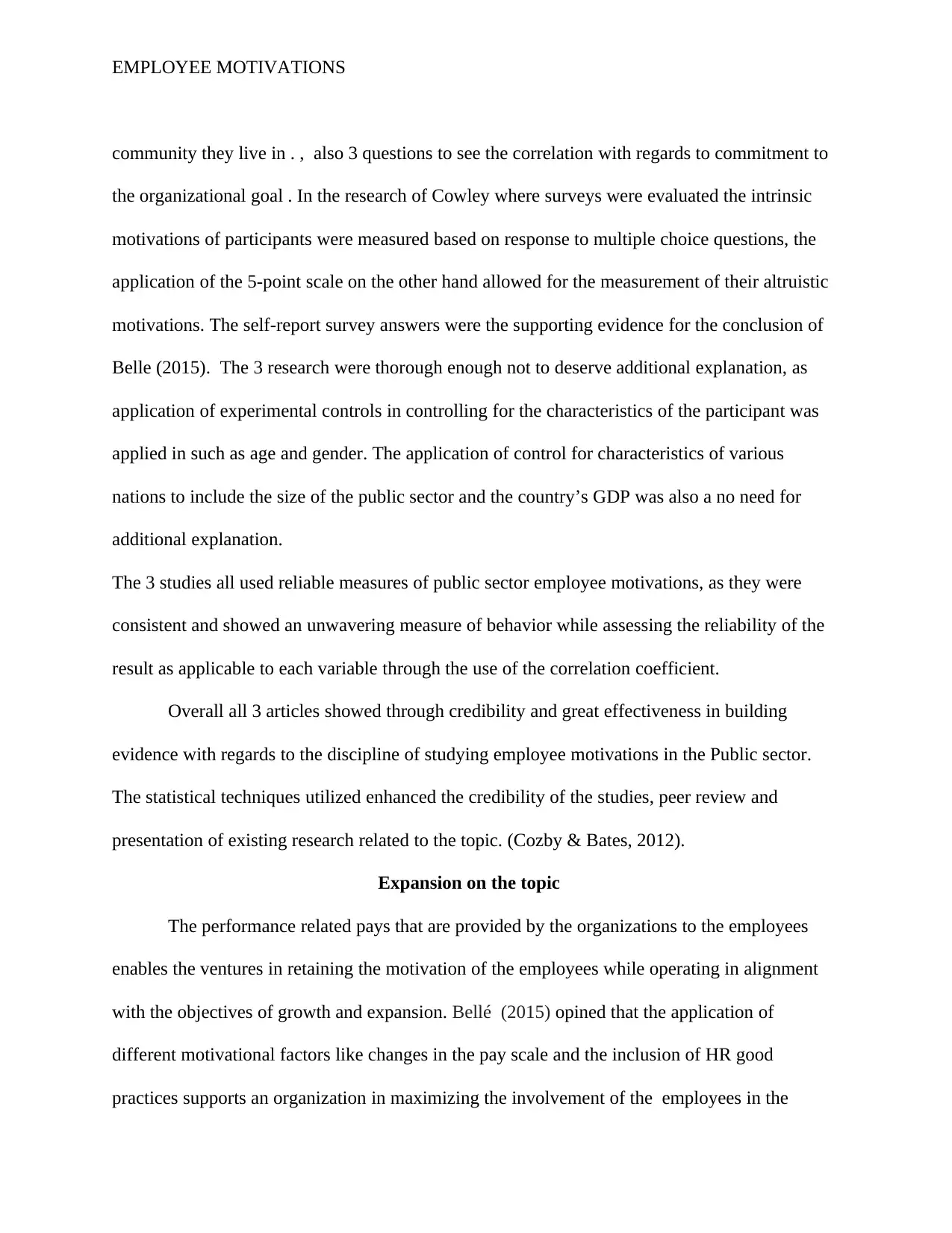
EMPLOYEE MOTIVATIONS
community they live in . , also 3 questions to see the correlation with regards to commitment to
the organizational goal . In the research of Cowley where surveys were evaluated the intrinsic
motivations of participants were measured based on response to multiple choice questions, the
application of the 5-point scale on the other hand allowed for the measurement of their altruistic
motivations. The self-report survey answers were the supporting evidence for the conclusion of
Belle (2015). The 3 research were thorough enough not to deserve additional explanation, as
application of experimental controls in controlling for the characteristics of the participant was
applied in such as age and gender. The application of control for characteristics of various
nations to include the size of the public sector and the country’s GDP was also a no need for
additional explanation.
The 3 studies all used reliable measures of public sector employee motivations, as they were
consistent and showed an unwavering measure of behavior while assessing the reliability of the
result as applicable to each variable through the use of the correlation coefficient.
Overall all 3 articles showed through credibility and great effectiveness in building
evidence with regards to the discipline of studying employee motivations in the Public sector.
The statistical techniques utilized enhanced the credibility of the studies, peer review and
presentation of existing research related to the topic. (Cozby & Bates, 2012).
Expansion on the topic
The performance related pays that are provided by the organizations to the employees
enables the ventures in retaining the motivation of the employees while operating in alignment
with the objectives of growth and expansion. Bellé (2015) opined that the application of
different motivational factors like changes in the pay scale and the inclusion of HR good
practices supports an organization in maximizing the involvement of the employees in the
community they live in . , also 3 questions to see the correlation with regards to commitment to
the organizational goal . In the research of Cowley where surveys were evaluated the intrinsic
motivations of participants were measured based on response to multiple choice questions, the
application of the 5-point scale on the other hand allowed for the measurement of their altruistic
motivations. The self-report survey answers were the supporting evidence for the conclusion of
Belle (2015). The 3 research were thorough enough not to deserve additional explanation, as
application of experimental controls in controlling for the characteristics of the participant was
applied in such as age and gender. The application of control for characteristics of various
nations to include the size of the public sector and the country’s GDP was also a no need for
additional explanation.
The 3 studies all used reliable measures of public sector employee motivations, as they were
consistent and showed an unwavering measure of behavior while assessing the reliability of the
result as applicable to each variable through the use of the correlation coefficient.
Overall all 3 articles showed through credibility and great effectiveness in building
evidence with regards to the discipline of studying employee motivations in the Public sector.
The statistical techniques utilized enhanced the credibility of the studies, peer review and
presentation of existing research related to the topic. (Cozby & Bates, 2012).
Expansion on the topic
The performance related pays that are provided by the organizations to the employees
enables the ventures in retaining the motivation of the employees while operating in alignment
with the objectives of growth and expansion. Bellé (2015) opined that the application of
different motivational factors like changes in the pay scale and the inclusion of HR good
practices supports an organization in maximizing the involvement of the employees in the
Paraphrase This Document
Need a fresh take? Get an instant paraphrase of this document with our AI Paraphraser
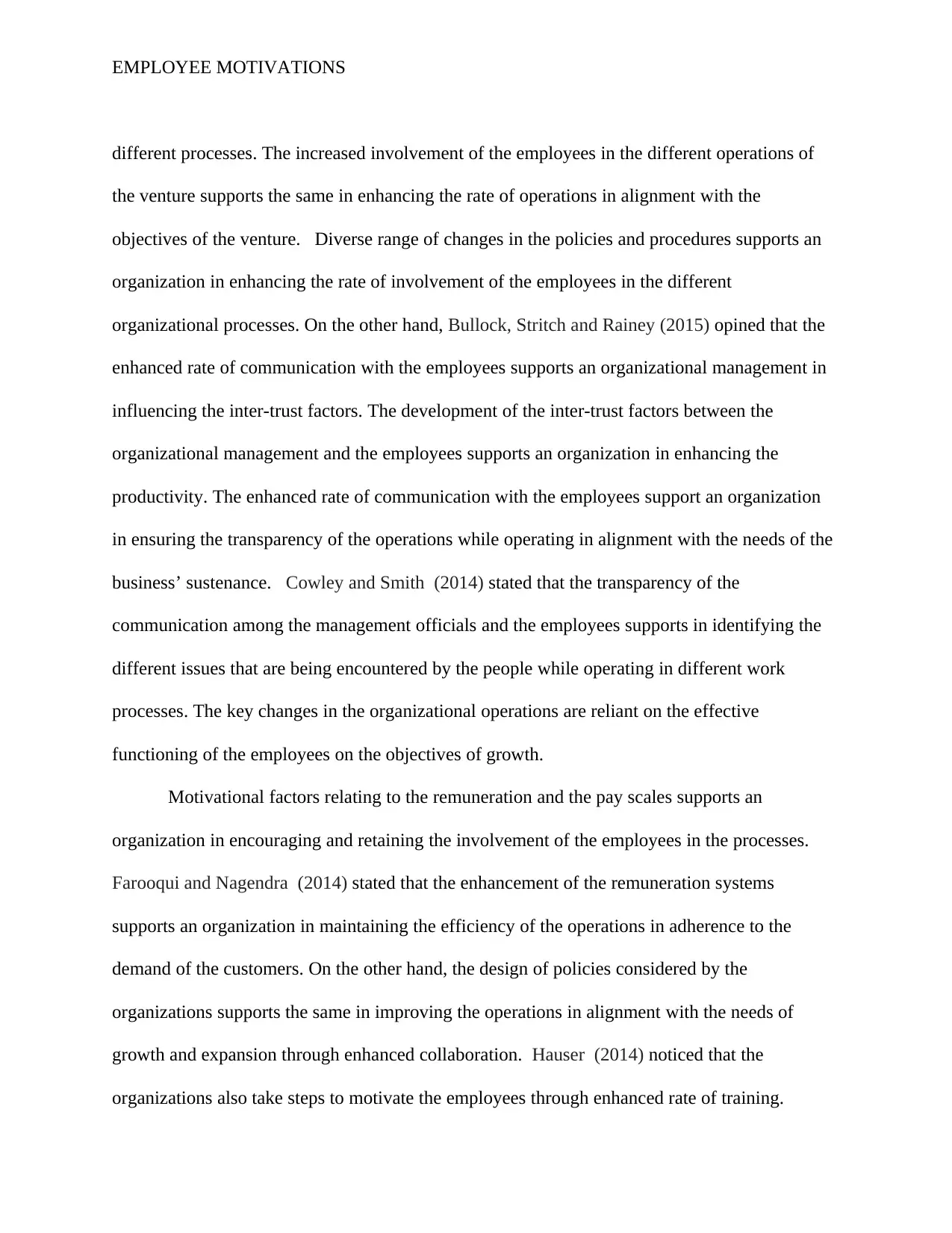
EMPLOYEE MOTIVATIONS
different processes. The increased involvement of the employees in the different operations of
the venture supports the same in enhancing the rate of operations in alignment with the
objectives of the venture. Diverse range of changes in the policies and procedures supports an
organization in enhancing the rate of involvement of the employees in the different
organizational processes. On the other hand, Bullock, Stritch and Rainey (2015) opined that the
enhanced rate of communication with the employees supports an organizational management in
influencing the inter-trust factors. The development of the inter-trust factors between the
organizational management and the employees supports an organization in enhancing the
productivity. The enhanced rate of communication with the employees support an organization
in ensuring the transparency of the operations while operating in alignment with the needs of the
business’ sustenance. Cowley and Smith (2014) stated that the transparency of the
communication among the management officials and the employees supports in identifying the
different issues that are being encountered by the people while operating in different work
processes. The key changes in the organizational operations are reliant on the effective
functioning of the employees on the objectives of growth.
Motivational factors relating to the remuneration and the pay scales supports an
organization in encouraging and retaining the involvement of the employees in the processes.
Farooqui and Nagendra (2014) stated that the enhancement of the remuneration systems
supports an organization in maintaining the efficiency of the operations in adherence to the
demand of the customers. On the other hand, the design of policies considered by the
organizations supports the same in improving the operations in alignment with the needs of
growth and expansion through enhanced collaboration. Hauser (2014) noticed that the
organizations also take steps to motivate the employees through enhanced rate of training.
different processes. The increased involvement of the employees in the different operations of
the venture supports the same in enhancing the rate of operations in alignment with the
objectives of the venture. Diverse range of changes in the policies and procedures supports an
organization in enhancing the rate of involvement of the employees in the different
organizational processes. On the other hand, Bullock, Stritch and Rainey (2015) opined that the
enhanced rate of communication with the employees supports an organizational management in
influencing the inter-trust factors. The development of the inter-trust factors between the
organizational management and the employees supports an organization in enhancing the
productivity. The enhanced rate of communication with the employees support an organization
in ensuring the transparency of the operations while operating in alignment with the needs of the
business’ sustenance. Cowley and Smith (2014) stated that the transparency of the
communication among the management officials and the employees supports in identifying the
different issues that are being encountered by the people while operating in different work
processes. The key changes in the organizational operations are reliant on the effective
functioning of the employees on the objectives of growth.
Motivational factors relating to the remuneration and the pay scales supports an
organization in encouraging and retaining the involvement of the employees in the processes.
Farooqui and Nagendra (2014) stated that the enhancement of the remuneration systems
supports an organization in maintaining the efficiency of the operations in adherence to the
demand of the customers. On the other hand, the design of policies considered by the
organizations supports the same in improving the operations in alignment with the needs of
growth and expansion through enhanced collaboration. Hauser (2014) noticed that the
organizations also take steps to motivate the employees through enhanced rate of training.
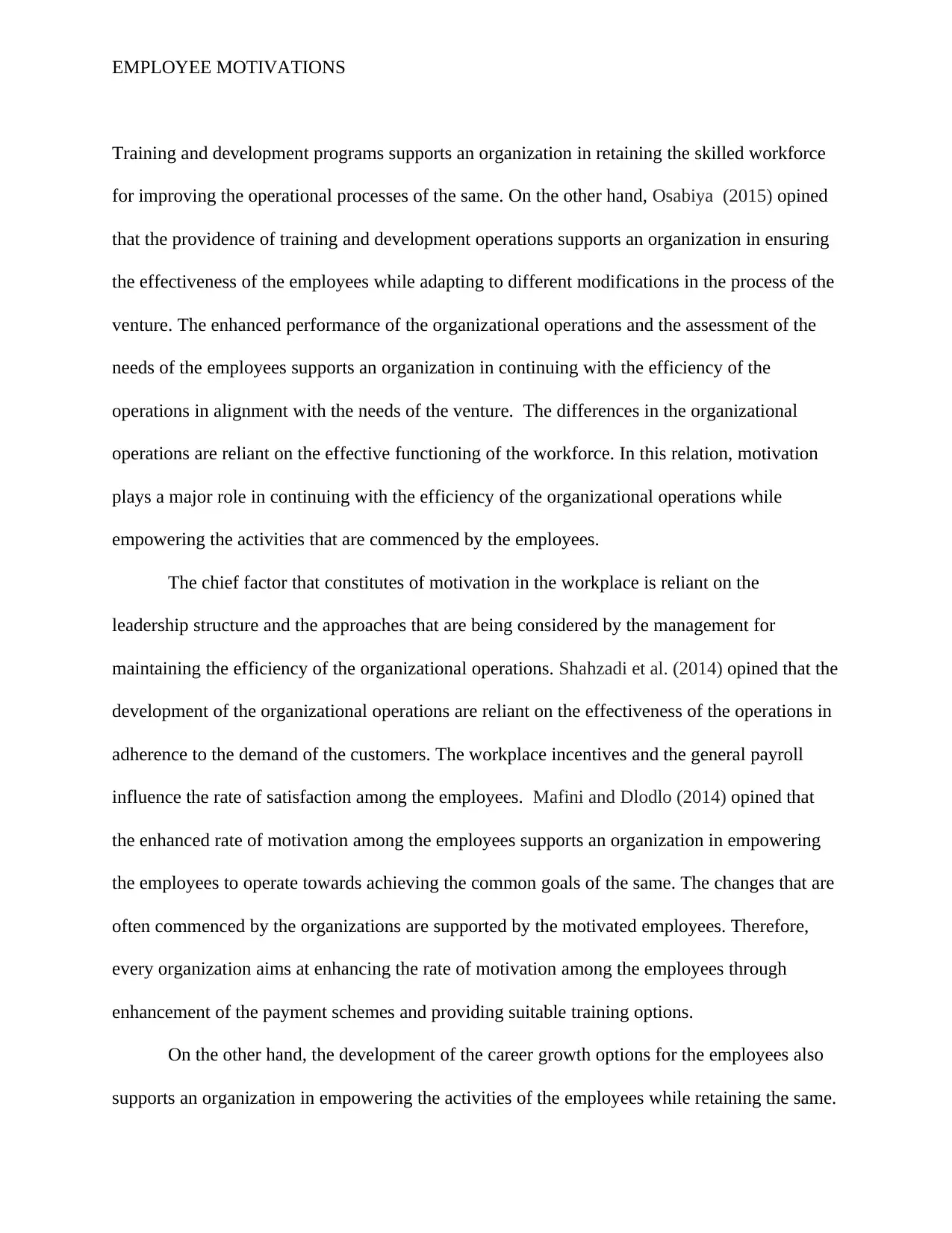
EMPLOYEE MOTIVATIONS
Training and development programs supports an organization in retaining the skilled workforce
for improving the operational processes of the same. On the other hand, Osabiya (2015) opined
that the providence of training and development operations supports an organization in ensuring
the effectiveness of the employees while adapting to different modifications in the process of the
venture. The enhanced performance of the organizational operations and the assessment of the
needs of the employees supports an organization in continuing with the efficiency of the
operations in alignment with the needs of the venture. The differences in the organizational
operations are reliant on the effective functioning of the workforce. In this relation, motivation
plays a major role in continuing with the efficiency of the organizational operations while
empowering the activities that are commenced by the employees.
The chief factor that constitutes of motivation in the workplace is reliant on the
leadership structure and the approaches that are being considered by the management for
maintaining the efficiency of the organizational operations. Shahzadi et al. (2014) opined that the
development of the organizational operations are reliant on the effectiveness of the operations in
adherence to the demand of the customers. The workplace incentives and the general payroll
influence the rate of satisfaction among the employees. Mafini and Dlodlo (2014) opined that
the enhanced rate of motivation among the employees supports an organization in empowering
the employees to operate towards achieving the common goals of the same. The changes that are
often commenced by the organizations are supported by the motivated employees. Therefore,
every organization aims at enhancing the rate of motivation among the employees through
enhancement of the payment schemes and providing suitable training options.
On the other hand, the development of the career growth options for the employees also
supports an organization in empowering the activities of the employees while retaining the same.
Training and development programs supports an organization in retaining the skilled workforce
for improving the operational processes of the same. On the other hand, Osabiya (2015) opined
that the providence of training and development operations supports an organization in ensuring
the effectiveness of the employees while adapting to different modifications in the process of the
venture. The enhanced performance of the organizational operations and the assessment of the
needs of the employees supports an organization in continuing with the efficiency of the
operations in alignment with the needs of the venture. The differences in the organizational
operations are reliant on the effective functioning of the workforce. In this relation, motivation
plays a major role in continuing with the efficiency of the organizational operations while
empowering the activities that are commenced by the employees.
The chief factor that constitutes of motivation in the workplace is reliant on the
leadership structure and the approaches that are being considered by the management for
maintaining the efficiency of the organizational operations. Shahzadi et al. (2014) opined that the
development of the organizational operations are reliant on the effectiveness of the operations in
adherence to the demand of the customers. The workplace incentives and the general payroll
influence the rate of satisfaction among the employees. Mafini and Dlodlo (2014) opined that
the enhanced rate of motivation among the employees supports an organization in empowering
the employees to operate towards achieving the common goals of the same. The changes that are
often commenced by the organizations are supported by the motivated employees. Therefore,
every organization aims at enhancing the rate of motivation among the employees through
enhancement of the payment schemes and providing suitable training options.
On the other hand, the development of the career growth options for the employees also
supports an organization in empowering the activities of the employees while retaining the same.
⊘ This is a preview!⊘
Do you want full access?
Subscribe today to unlock all pages.

Trusted by 1+ million students worldwide
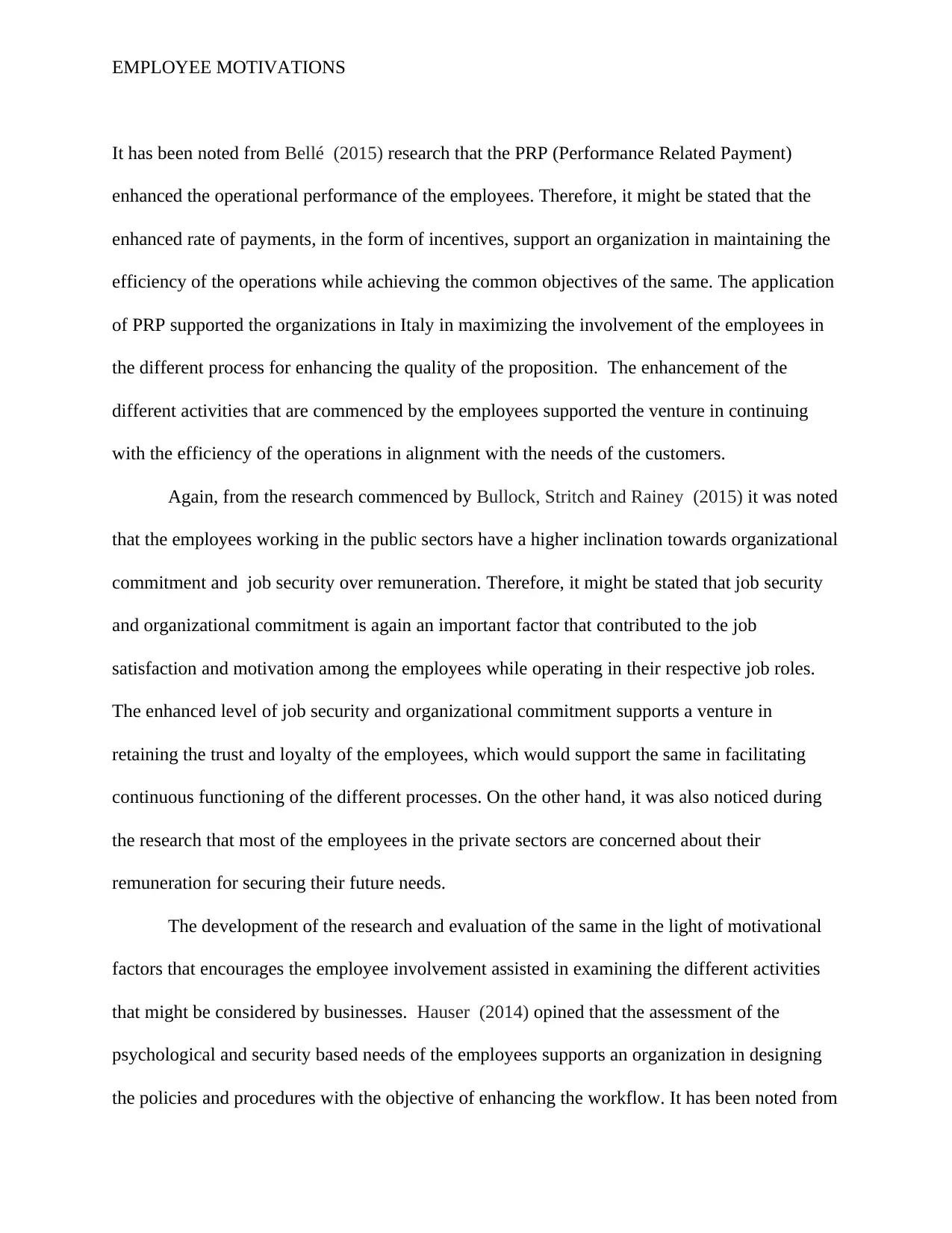
EMPLOYEE MOTIVATIONS
It has been noted from Bellé (2015) research that the PRP (Performance Related Payment)
enhanced the operational performance of the employees. Therefore, it might be stated that the
enhanced rate of payments, in the form of incentives, support an organization in maintaining the
efficiency of the operations while achieving the common objectives of the same. The application
of PRP supported the organizations in Italy in maximizing the involvement of the employees in
the different process for enhancing the quality of the proposition. The enhancement of the
different activities that are commenced by the employees supported the venture in continuing
with the efficiency of the operations in alignment with the needs of the customers.
Again, from the research commenced by Bullock, Stritch and Rainey (2015) it was noted
that the employees working in the public sectors have a higher inclination towards organizational
commitment and job security over remuneration. Therefore, it might be stated that job security
and organizational commitment is again an important factor that contributed to the job
satisfaction and motivation among the employees while operating in their respective job roles.
The enhanced level of job security and organizational commitment supports a venture in
retaining the trust and loyalty of the employees, which would support the same in facilitating
continuous functioning of the different processes. On the other hand, it was also noticed during
the research that most of the employees in the private sectors are concerned about their
remuneration for securing their future needs.
The development of the research and evaluation of the same in the light of motivational
factors that encourages the employee involvement assisted in examining the different activities
that might be considered by businesses. Hauser (2014) opined that the assessment of the
psychological and security based needs of the employees supports an organization in designing
the policies and procedures with the objective of enhancing the workflow. It has been noted from
It has been noted from Bellé (2015) research that the PRP (Performance Related Payment)
enhanced the operational performance of the employees. Therefore, it might be stated that the
enhanced rate of payments, in the form of incentives, support an organization in maintaining the
efficiency of the operations while achieving the common objectives of the same. The application
of PRP supported the organizations in Italy in maximizing the involvement of the employees in
the different process for enhancing the quality of the proposition. The enhancement of the
different activities that are commenced by the employees supported the venture in continuing
with the efficiency of the operations in alignment with the needs of the customers.
Again, from the research commenced by Bullock, Stritch and Rainey (2015) it was noted
that the employees working in the public sectors have a higher inclination towards organizational
commitment and job security over remuneration. Therefore, it might be stated that job security
and organizational commitment is again an important factor that contributed to the job
satisfaction and motivation among the employees while operating in their respective job roles.
The enhanced level of job security and organizational commitment supports a venture in
retaining the trust and loyalty of the employees, which would support the same in facilitating
continuous functioning of the different processes. On the other hand, it was also noticed during
the research that most of the employees in the private sectors are concerned about their
remuneration for securing their future needs.
The development of the research and evaluation of the same in the light of motivational
factors that encourages the employee involvement assisted in examining the different activities
that might be considered by businesses. Hauser (2014) opined that the assessment of the
psychological and security based needs of the employees supports an organization in designing
the policies and procedures with the objective of enhancing the workflow. It has been noted from
Paraphrase This Document
Need a fresh take? Get an instant paraphrase of this document with our AI Paraphraser
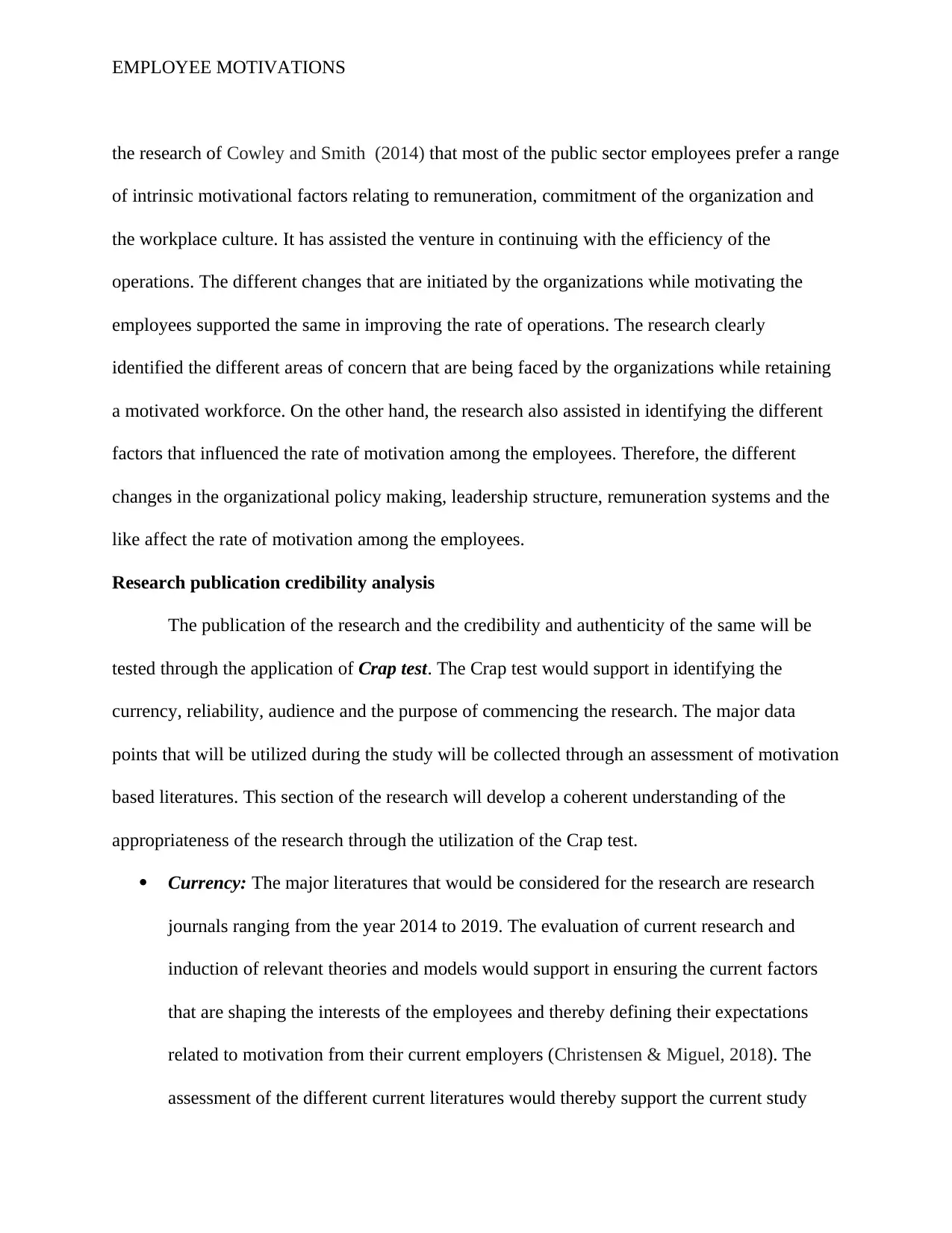
EMPLOYEE MOTIVATIONS
the research of Cowley and Smith (2014) that most of the public sector employees prefer a range
of intrinsic motivational factors relating to remuneration, commitment of the organization and
the workplace culture. It has assisted the venture in continuing with the efficiency of the
operations. The different changes that are initiated by the organizations while motivating the
employees supported the same in improving the rate of operations. The research clearly
identified the different areas of concern that are being faced by the organizations while retaining
a motivated workforce. On the other hand, the research also assisted in identifying the different
factors that influenced the rate of motivation among the employees. Therefore, the different
changes in the organizational policy making, leadership structure, remuneration systems and the
like affect the rate of motivation among the employees.
Research publication credibility analysis
The publication of the research and the credibility and authenticity of the same will be
tested through the application of Crap test. The Crap test would support in identifying the
currency, reliability, audience and the purpose of commencing the research. The major data
points that will be utilized during the study will be collected through an assessment of motivation
based literatures. This section of the research will develop a coherent understanding of the
appropriateness of the research through the utilization of the Crap test.
Currency: The major literatures that would be considered for the research are research
journals ranging from the year 2014 to 2019. The evaluation of current research and
induction of relevant theories and models would support in ensuring the current factors
that are shaping the interests of the employees and thereby defining their expectations
related to motivation from their current employers (Christensen & Miguel, 2018). The
assessment of the different current literatures would thereby support the current study
the research of Cowley and Smith (2014) that most of the public sector employees prefer a range
of intrinsic motivational factors relating to remuneration, commitment of the organization and
the workplace culture. It has assisted the venture in continuing with the efficiency of the
operations. The different changes that are initiated by the organizations while motivating the
employees supported the same in improving the rate of operations. The research clearly
identified the different areas of concern that are being faced by the organizations while retaining
a motivated workforce. On the other hand, the research also assisted in identifying the different
factors that influenced the rate of motivation among the employees. Therefore, the different
changes in the organizational policy making, leadership structure, remuneration systems and the
like affect the rate of motivation among the employees.
Research publication credibility analysis
The publication of the research and the credibility and authenticity of the same will be
tested through the application of Crap test. The Crap test would support in identifying the
currency, reliability, audience and the purpose of commencing the research. The major data
points that will be utilized during the study will be collected through an assessment of motivation
based literatures. This section of the research will develop a coherent understanding of the
appropriateness of the research through the utilization of the Crap test.
Currency: The major literatures that would be considered for the research are research
journals ranging from the year 2014 to 2019. The evaluation of current research and
induction of relevant theories and models would support in ensuring the current factors
that are shaping the interests of the employees and thereby defining their expectations
related to motivation from their current employers (Christensen & Miguel, 2018). The
assessment of the different current literatures would thereby support the current study
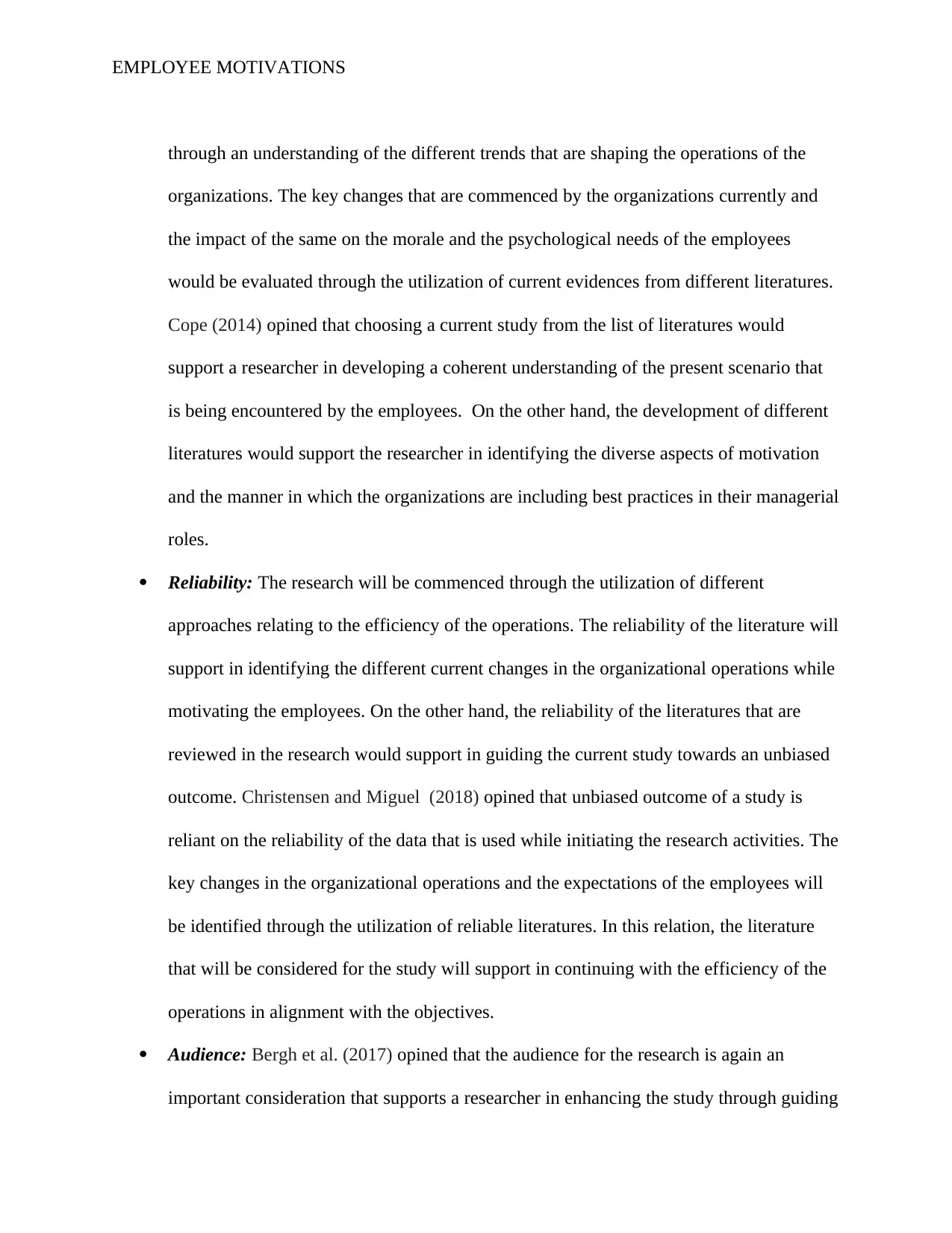
EMPLOYEE MOTIVATIONS
through an understanding of the different trends that are shaping the operations of the
organizations. The key changes that are commenced by the organizations currently and
the impact of the same on the morale and the psychological needs of the employees
would be evaluated through the utilization of current evidences from different literatures.
Cope (2014) opined that choosing a current study from the list of literatures would
support a researcher in developing a coherent understanding of the present scenario that
is being encountered by the employees. On the other hand, the development of different
literatures would support the researcher in identifying the diverse aspects of motivation
and the manner in which the organizations are including best practices in their managerial
roles.
Reliability: The research will be commenced through the utilization of different
approaches relating to the efficiency of the operations. The reliability of the literature will
support in identifying the different current changes in the organizational operations while
motivating the employees. On the other hand, the reliability of the literatures that are
reviewed in the research would support in guiding the current study towards an unbiased
outcome. Christensen and Miguel (2018) opined that unbiased outcome of a study is
reliant on the reliability of the data that is used while initiating the research activities. The
key changes in the organizational operations and the expectations of the employees will
be identified through the utilization of reliable literatures. In this relation, the literature
that will be considered for the study will support in continuing with the efficiency of the
operations in alignment with the objectives.
Audience: Bergh et al. (2017) opined that the audience for the research is again an
important consideration that supports a researcher in enhancing the study through guiding
through an understanding of the different trends that are shaping the operations of the
organizations. The key changes that are commenced by the organizations currently and
the impact of the same on the morale and the psychological needs of the employees
would be evaluated through the utilization of current evidences from different literatures.
Cope (2014) opined that choosing a current study from the list of literatures would
support a researcher in developing a coherent understanding of the present scenario that
is being encountered by the employees. On the other hand, the development of different
literatures would support the researcher in identifying the diverse aspects of motivation
and the manner in which the organizations are including best practices in their managerial
roles.
Reliability: The research will be commenced through the utilization of different
approaches relating to the efficiency of the operations. The reliability of the literature will
support in identifying the different current changes in the organizational operations while
motivating the employees. On the other hand, the reliability of the literatures that are
reviewed in the research would support in guiding the current study towards an unbiased
outcome. Christensen and Miguel (2018) opined that unbiased outcome of a study is
reliant on the reliability of the data that is used while initiating the research activities. The
key changes in the organizational operations and the expectations of the employees will
be identified through the utilization of reliable literatures. In this relation, the literature
that will be considered for the study will support in continuing with the efficiency of the
operations in alignment with the objectives.
Audience: Bergh et al. (2017) opined that the audience for the research is again an
important consideration that supports a researcher in enhancing the study through guiding
⊘ This is a preview!⊘
Do you want full access?
Subscribe today to unlock all pages.

Trusted by 1+ million students worldwide
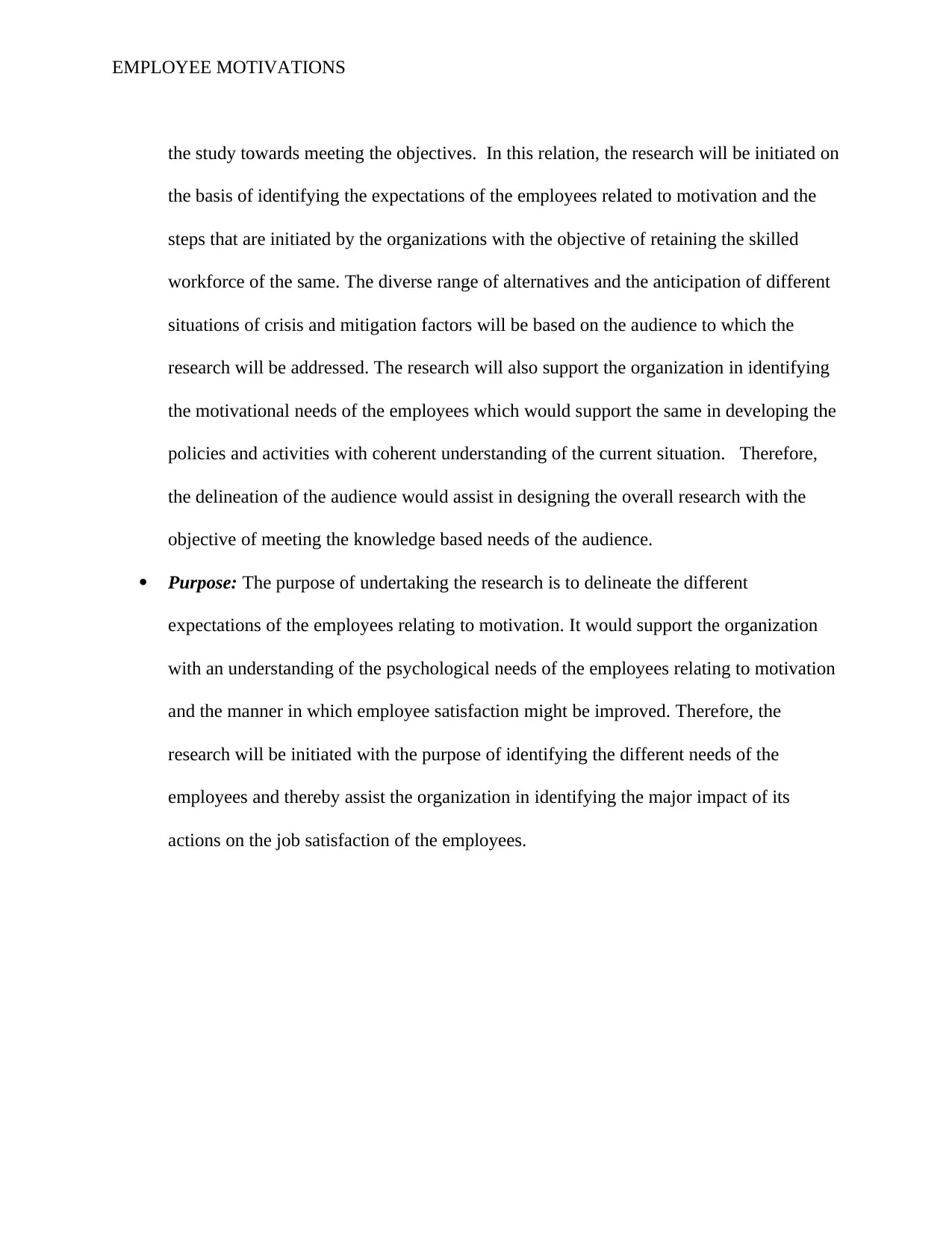
EMPLOYEE MOTIVATIONS
the study towards meeting the objectives. In this relation, the research will be initiated on
the basis of identifying the expectations of the employees related to motivation and the
steps that are initiated by the organizations with the objective of retaining the skilled
workforce of the same. The diverse range of alternatives and the anticipation of different
situations of crisis and mitigation factors will be based on the audience to which the
research will be addressed. The research will also support the organization in identifying
the motivational needs of the employees which would support the same in developing the
policies and activities with coherent understanding of the current situation. Therefore,
the delineation of the audience would assist in designing the overall research with the
objective of meeting the knowledge based needs of the audience.
Purpose: The purpose of undertaking the research is to delineate the different
expectations of the employees relating to motivation. It would support the organization
with an understanding of the psychological needs of the employees relating to motivation
and the manner in which employee satisfaction might be improved. Therefore, the
research will be initiated with the purpose of identifying the different needs of the
employees and thereby assist the organization in identifying the major impact of its
actions on the job satisfaction of the employees.
the study towards meeting the objectives. In this relation, the research will be initiated on
the basis of identifying the expectations of the employees related to motivation and the
steps that are initiated by the organizations with the objective of retaining the skilled
workforce of the same. The diverse range of alternatives and the anticipation of different
situations of crisis and mitigation factors will be based on the audience to which the
research will be addressed. The research will also support the organization in identifying
the motivational needs of the employees which would support the same in developing the
policies and activities with coherent understanding of the current situation. Therefore,
the delineation of the audience would assist in designing the overall research with the
objective of meeting the knowledge based needs of the audience.
Purpose: The purpose of undertaking the research is to delineate the different
expectations of the employees relating to motivation. It would support the organization
with an understanding of the psychological needs of the employees relating to motivation
and the manner in which employee satisfaction might be improved. Therefore, the
research will be initiated with the purpose of identifying the different needs of the
employees and thereby assist the organization in identifying the major impact of its
actions on the job satisfaction of the employees.
Paraphrase This Document
Need a fresh take? Get an instant paraphrase of this document with our AI Paraphraser
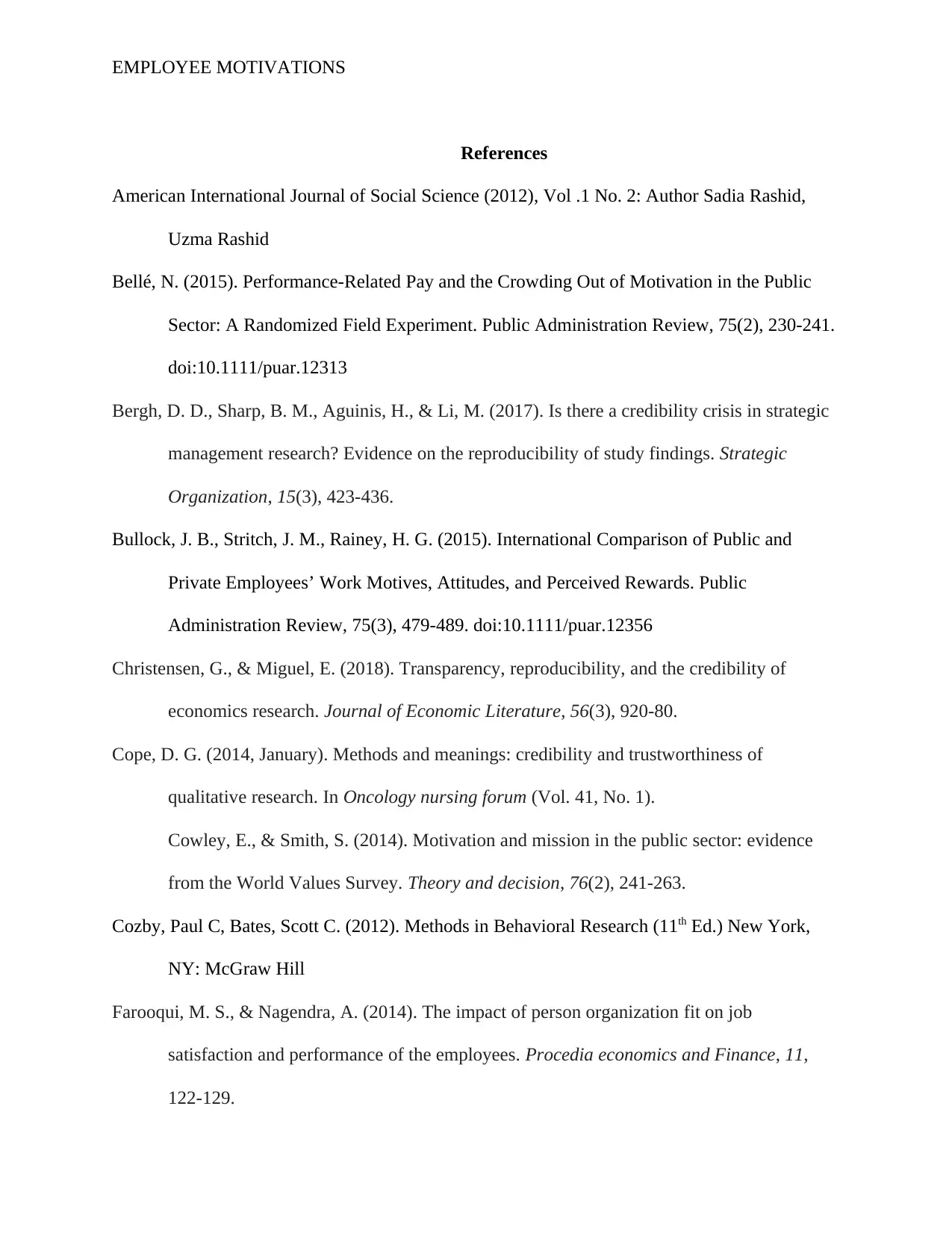
EMPLOYEE MOTIVATIONS
References
American International Journal of Social Science (2012), Vol .1 No. 2: Author Sadia Rashid,
Uzma Rashid
Bellé, N. (2015). Performance-Related Pay and the Crowding Out of Motivation in the Public
Sector: A Randomized Field Experiment. Public Administration Review, 75(2), 230-241.
doi:10.1111/puar.12313
Bergh, D. D., Sharp, B. M., Aguinis, H., & Li, M. (2017). Is there a credibility crisis in strategic
management research? Evidence on the reproducibility of study findings. Strategic
Organization, 15(3), 423-436.
Bullock, J. B., Stritch, J. M., Rainey, H. G. (2015). International Comparison of Public and
Private Employees’ Work Motives, Attitudes, and Perceived Rewards. Public
Administration Review, 75(3), 479-489. doi:10.1111/puar.12356
Christensen, G., & Miguel, E. (2018). Transparency, reproducibility, and the credibility of
economics research. Journal of Economic Literature, 56(3), 920-80.
Cope, D. G. (2014, January). Methods and meanings: credibility and trustworthiness of
qualitative research. In Oncology nursing forum (Vol. 41, No. 1).
Cowley, E., & Smith, S. (2014). Motivation and mission in the public sector: evidence
from the World Values Survey. Theory and decision, 76(2), 241-263.
Cozby, Paul C, Bates, Scott C. (2012). Methods in Behavioral Research (11th Ed.) New York,
NY: McGraw Hill
Farooqui, M. S., & Nagendra, A. (2014). The impact of person organization fit on job
satisfaction and performance of the employees. Procedia economics and Finance, 11,
122-129.
References
American International Journal of Social Science (2012), Vol .1 No. 2: Author Sadia Rashid,
Uzma Rashid
Bellé, N. (2015). Performance-Related Pay and the Crowding Out of Motivation in the Public
Sector: A Randomized Field Experiment. Public Administration Review, 75(2), 230-241.
doi:10.1111/puar.12313
Bergh, D. D., Sharp, B. M., Aguinis, H., & Li, M. (2017). Is there a credibility crisis in strategic
management research? Evidence on the reproducibility of study findings. Strategic
Organization, 15(3), 423-436.
Bullock, J. B., Stritch, J. M., Rainey, H. G. (2015). International Comparison of Public and
Private Employees’ Work Motives, Attitudes, and Perceived Rewards. Public
Administration Review, 75(3), 479-489. doi:10.1111/puar.12356
Christensen, G., & Miguel, E. (2018). Transparency, reproducibility, and the credibility of
economics research. Journal of Economic Literature, 56(3), 920-80.
Cope, D. G. (2014, January). Methods and meanings: credibility and trustworthiness of
qualitative research. In Oncology nursing forum (Vol. 41, No. 1).
Cowley, E., & Smith, S. (2014). Motivation and mission in the public sector: evidence
from the World Values Survey. Theory and decision, 76(2), 241-263.
Cozby, Paul C, Bates, Scott C. (2012). Methods in Behavioral Research (11th Ed.) New York,
NY: McGraw Hill
Farooqui, M. S., & Nagendra, A. (2014). The impact of person organization fit on job
satisfaction and performance of the employees. Procedia economics and Finance, 11,
122-129.
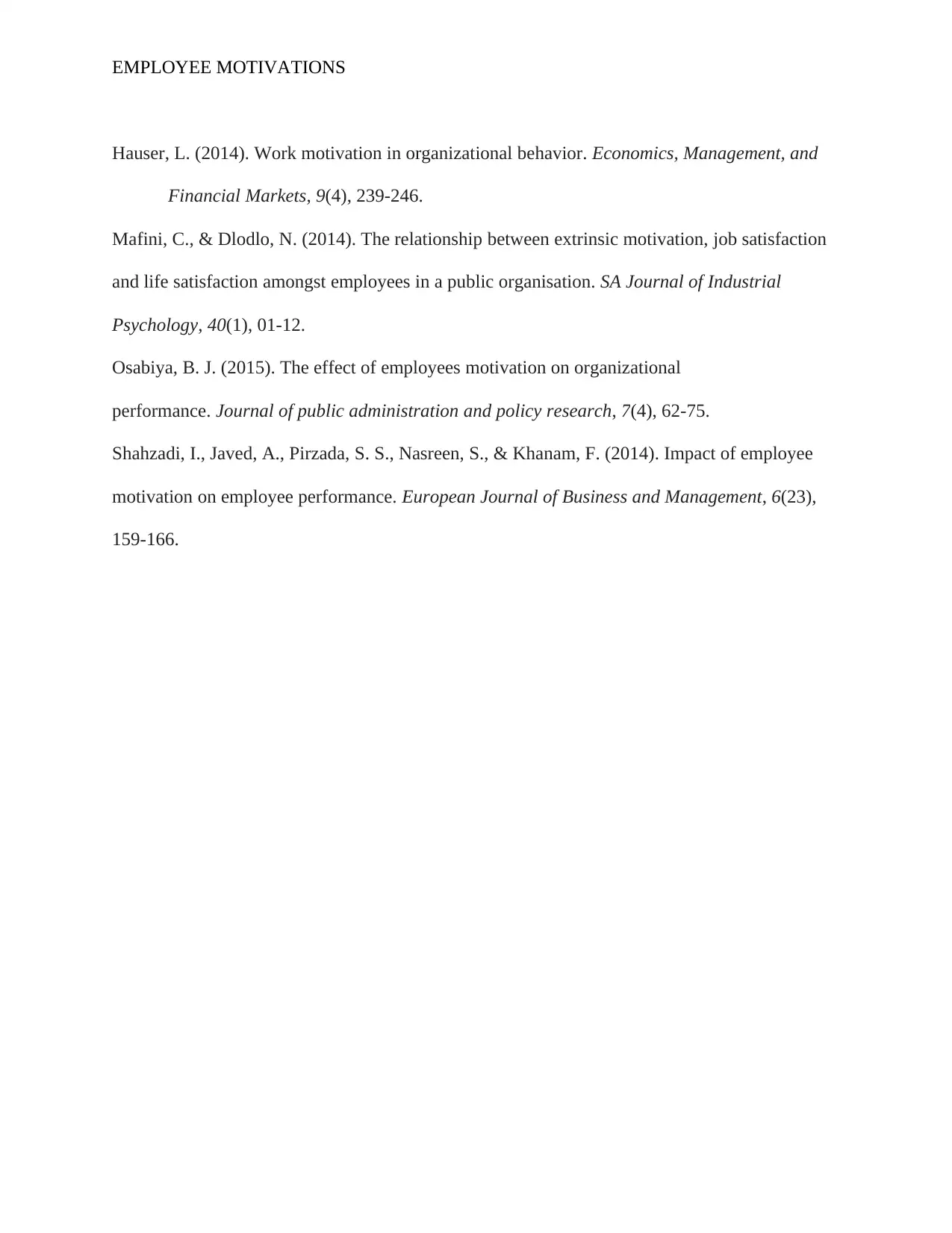
EMPLOYEE MOTIVATIONS
Hauser, L. (2014). Work motivation in organizational behavior. Economics, Management, and
Financial Markets, 9(4), 239-246.
Mafini, C., & Dlodlo, N. (2014). The relationship between extrinsic motivation, job satisfaction
and life satisfaction amongst employees in a public organisation. SA Journal of Industrial
Psychology, 40(1), 01-12.
Osabiya, B. J. (2015). The effect of employees motivation on organizational
performance. Journal of public administration and policy research, 7(4), 62-75.
Shahzadi, I., Javed, A., Pirzada, S. S., Nasreen, S., & Khanam, F. (2014). Impact of employee
motivation on employee performance. European Journal of Business and Management, 6(23),
159-166.
Hauser, L. (2014). Work motivation in organizational behavior. Economics, Management, and
Financial Markets, 9(4), 239-246.
Mafini, C., & Dlodlo, N. (2014). The relationship between extrinsic motivation, job satisfaction
and life satisfaction amongst employees in a public organisation. SA Journal of Industrial
Psychology, 40(1), 01-12.
Osabiya, B. J. (2015). The effect of employees motivation on organizational
performance. Journal of public administration and policy research, 7(4), 62-75.
Shahzadi, I., Javed, A., Pirzada, S. S., Nasreen, S., & Khanam, F. (2014). Impact of employee
motivation on employee performance. European Journal of Business and Management, 6(23),
159-166.
⊘ This is a preview!⊘
Do you want full access?
Subscribe today to unlock all pages.

Trusted by 1+ million students worldwide
1 out of 12
Your All-in-One AI-Powered Toolkit for Academic Success.
+13062052269
info@desklib.com
Available 24*7 on WhatsApp / Email
![[object Object]](/_next/static/media/star-bottom.7253800d.svg)
Unlock your academic potential
Copyright © 2020–2025 A2Z Services. All Rights Reserved. Developed and managed by ZUCOL.

